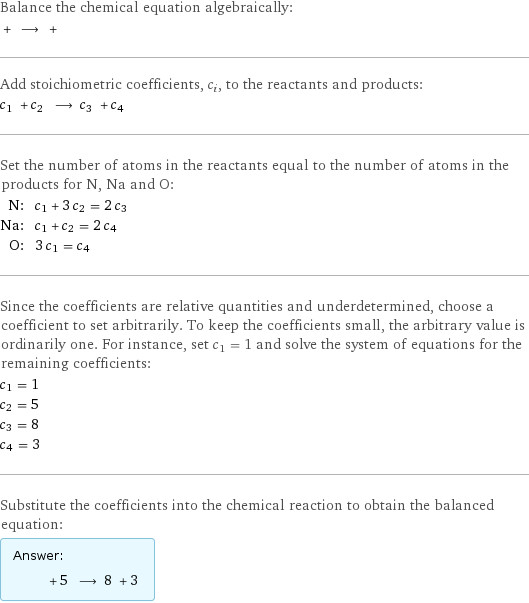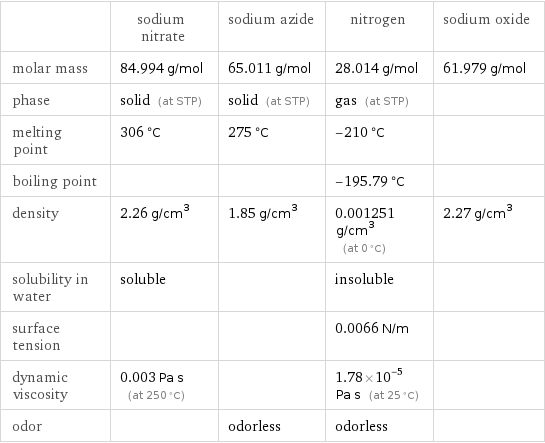Input interpretation

sodium nitrate + sodium azide ⟶ nitrogen + sodium oxide
Balanced equation

Balance the chemical equation algebraically: + ⟶ + Add stoichiometric coefficients, c_i, to the reactants and products: c_1 + c_2 ⟶ c_3 + c_4 Set the number of atoms in the reactants equal to the number of atoms in the products for N, Na and O: N: | c_1 + 3 c_2 = 2 c_3 Na: | c_1 + c_2 = 2 c_4 O: | 3 c_1 = c_4 Since the coefficients are relative quantities and underdetermined, choose a coefficient to set arbitrarily. To keep the coefficients small, the arbitrary value is ordinarily one. For instance, set c_1 = 1 and solve the system of equations for the remaining coefficients: c_1 = 1 c_2 = 5 c_3 = 8 c_4 = 3 Substitute the coefficients into the chemical reaction to obtain the balanced equation: Answer: | | + 5 ⟶ 8 + 3
Structures

+ ⟶ +
Names

sodium nitrate + sodium azide ⟶ nitrogen + sodium oxide
Chemical names and formulas

| sodium nitrate | sodium azide | nitrogen | sodium oxide Hill formula | NNaO_3 | N_3Na | N_2 | Na_2O name | sodium nitrate | sodium azide | nitrogen | sodium oxide IUPAC name | sodium nitrate | | molecular nitrogen | disodium oxygen(-2) anion
Substance properties

| sodium nitrate | sodium azide | nitrogen | sodium oxide molar mass | 84.994 g/mol | 65.011 g/mol | 28.014 g/mol | 61.979 g/mol phase | solid (at STP) | solid (at STP) | gas (at STP) | melting point | 306 °C | 275 °C | -210 °C | boiling point | | | -195.79 °C | density | 2.26 g/cm^3 | 1.85 g/cm^3 | 0.001251 g/cm^3 (at 0 °C) | 2.27 g/cm^3 solubility in water | soluble | | insoluble | surface tension | | | 0.0066 N/m | dynamic viscosity | 0.003 Pa s (at 250 °C) | | 1.78×10^-5 Pa s (at 25 °C) | odor | | odorless | odorless |
Units
